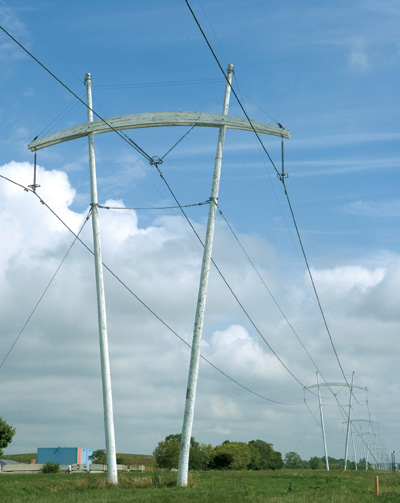 Photo: Deborah Guzman Meyer, Fermilab |
The power of pi
Believe it or not, most of Fermilab's power comes from pi. Electrical power, that is, as the shape of the lab's power poles is modeled after π, the symbol for the famous number. The π-poles were designed by founding director Robert Wilson during the construction of the lab. Amazingly, the original wooden poles are still standing, over 30 years later—but not without encountering some obstacles along the way.
Because the π-poles are wooden, they are subject to infestation from insects and woodpeckers. That's why engineer Joe Pathiyil is not only in charge of power distribution for the site, but he is also on continual woodpecker duty. In order to minimize the damage to any poles from woodpecker holes, "we fill the woodpecker holes with epoxy and put steel mesh around the area," explains Pathiyil.
While reliability and safety are important reasons to maintain these unique structures, they are not the only ones. "A lot of who we are at Fermilab is captured in our unique art and architecture," says Randy Ortgiesen, deputy head of Fermilab's Facilities Engineering Services Section. Engineering Group manager Ed Crumpley agrees, adding, "Wilson thought as a sculptor, not as an architect," when he designed Fermilab structures such as the Feynman Computing Center, the high rise that now bears his name, and, of course, the π-poles.
The π-poles are a symbol of the intellectual endeavors that take place at Fermilab, and—with protection, care, maintenance, and replacement as needed—they will continue to supply Fermilab with power for years to come.
Elizabeth Wade
Click here to download the pdf version of this article.






